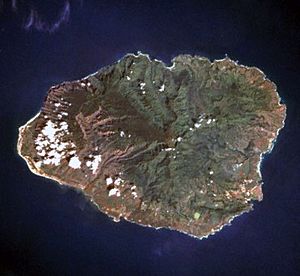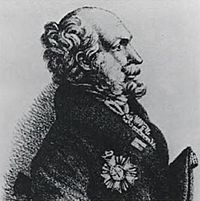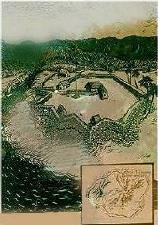Schäffer affair facts for kids
The Schäffer affair was a big diplomatic problem. It happened because of Georg Anton Schäffer, a German doctor. He tried to take over the Kingdom of Hawaii for the Russian Empire.
In January 1815, a ship called Bering got stuck during a storm near Waimea on Kauai. This ship belonged to the Russian-American Company (RAC). The island's leader, Kaumualii, took the goods from the ship. Later that year, Schäffer was sent from Russian America to get the goods back. But he ended up trying to get local allies to help him overthrow King Kamehameha I.
Schäffer's simple mission turned into a huge mistake for the company. Kaumualii wanted help against King Kamehameha. He invited Schäffer to his island. Kaumualii made Schäffer believe that the RAC could easily take over Hawaii. Schäffer then started planning a big attack on the Hawaiian islands. But the RAC governor, Alexander Andreyevich Baranov, did not approve these plans. He only told Schäffer to get the lost items back or get paid for them.
Local Native Hawaiians and American traders fought back against Schäffer. This made him give up and leave Hawaii in July 1817. The Russian-American Company lost a lot of money, over 200,000 rubles. They even sued Schäffer for the damages. But they later let him go back to Germany.
Contents
How the Problem Started
The Russian Empire and the Russian-American Company (RAC) first met Hawaiian King Kamehameha I in 1804. Russian ships visited Hawaii now and then. They mostly traded for food.
On January 29, 1815, a RAC ship named Bering stopped near Waimea on Kauai. The captain, James Bennett, was told to buy food and supplies for settlers in Russian America. The ship had furs and other goods worth a lot of money. The next night, the ship got stuck in a storm. Captain Bennett made a deal with King Kaumualii. He gave Kaumualii the wrecked ship. But the goods on board were still Russian property. Many Kauaians helped to save the furs and supplies. Still, Bennett later said that Kaumualii took both the ship and its cargo.
Two months later, the stranded crew was taken from Kauai by another ship. Captain Bennett and two other American captains wanted the RAC to send soldiers to get their goods back from Kaumualii. The governor, Baranov, thought about this idea. But he decided it was better to try for a peaceful solution.
Schäffer's Mission Begins
A mission was put together and sent to Hawaii in October. Georg Anton Schäffer was chosen to lead it. He used to be a doctor on a RAC ship. Baranov likely chose him because he didn't have anyone else available. His best officers were working at other RAC posts.
Baranov told Schäffer to act like a harmless explorer. He was to get King Kamehameha's approval. His real mission was to be kept secret. After gaining the king's favor, Schäffer was to ask for the goods taken from the Bering back. Or he could ask for payment in sandalwood. If that went well, Schäffer was to try to get a special deal to control all sandalwood trading. Baranov also sent a letter to Kamehameha. He warned that if Kaumualii did not pay for the lost goods, they would treat him as an enemy.
Schäffer arrived in Hawaii in November. What happened between Kamehameha and Schäffer is mostly known from Schäffer's own stories. Americans who were close to Kamehameha thought Schäffer's "naturalist" act was just a cover. Schäffer said these Americans made Kamehameha dislike Russians. But Schäffer helped the king and queen Ka'ahumanu with medical care. By December, he had won Kamehameha's trust again. Queen Ka'ahumanu and her brother soon sold him land. They also let him set up trading posts. Schäffer then explored the Hawaiian islands. He claimed Americans tried to hurt him during his travels. After that, he lived on Oahu. There he grew plants like maize, tobacco, and watermelons.
In February 1816, Baranov sent more help. The ship Otkrytie arrived with Lieutenant Podushkin. Podushkin's orders said to try for peace first. But if that failed, they were to invade Kauai. The orders said: "The whole island of Kauai should be taken in the name of our Sovereign Emperor of the Russias." The Otkrytie reached Hawaii on April 13. It then entered Honolulu Harbor on April 23. Another Russian ship, Il’mena, also arrived for repairs. Schäffer was in charge of all Russian forces, including the two ships. They had a final meeting with Kamehameha. But the king still refused to make any deals. Schäffer and Podushkin quickly sailed to Kauai on May 14. They reached the island three days later.
The Dream of Taking Over

Talks with Kaumualii started quickly and seemed good for Schäffer. Kaumualii must have seen that no one from Kamehameha was with the Russians. This made him bolder. Five days after Schäffer arrived, Kaumualii promised to be loyal to the Tsar of Russia. He called himself "the King of the Sandwich Islands in the North Pacific Ocean, Kauai and Niihau, and hereditary prince of the islands Oahu, Maui, Lanai".
Kaumualii also agreed to pay the RAC back for their losses in 1815. He also promised to give them control over all sandalwood trade. Kaumualii wore a Russian Naval uniform. He raised the Russian-American Company flag over Kauai. Another agreement was signed on July 1. This agreement said the Russians would get 500 local soldiers. These soldiers would help them take over Oahu, Lanai, Maui, and Molokai. The agreement also said Kaumualii would "refuse to trade with citizens of the United States."
Schäffer was given command of over three hundred Hawaiians. They started building forts and trading posts. Fort Elizabeth was built like a European star-shaped fort. It was made of stone and adobe. By the end of 1817, it was almost finished and had cannons. Schäffer also built two smaller forts, Alexander and Barclay-de-Tolly, without Hawaiian help. Schäffer was very excited. He sent messages to Baranov and to the Russian leaders in Saint Petersburg. He asked for ships to protect his "almost crazy plans."
He soon bought two ships from Americans for Kaumualii to use. The Avon cost 200,000 Spanish dollars. Its captain sailed to New Archangel to get paid by Baranov. Schäffer spent the summer of 1816 exploring Kauai. He gave new names to local places. He named the Hanalei River valley Schäfferthal. He named the Hanapepe river after the Don River.
But Kaumualii never planned to give up his lands. He used Schäffer for his own benefit against Kamehameha. He wanted to conquer more islands. Some early historians thought Kaumualii's revolt was started by Schäffer. But Kaumualii just wanted help from any foreign power. During the War of 1812, he sided with the Americans. But by 1815, that alliance ended. Schäffer's arrival fit perfectly into Kaumualii's plans. Baranov did not want to pay for such a war. He refused to pay for the Avon. He warned Schäffer not to make more political or business mistakes.
Giving Up and Leaving
Schäffer's "empire" started to fall apart in September 1816. He had to leave his colony in Oahu because of threats of violence. In December, Schäffer got unexpected help. The Russian military ship Rurick, led by Otto von Kotzebue, stopped in Hawaii. This was during a trip around the world. Kamehameha did not know Kotzebue's true purpose. He had 400 soldiers ready to fight off an expected landing. But Kotzebue convinced the king that he came in peace. He made it clear that the Russian government had nothing to do with Schäffer's plans. Kotzebue left without visiting his countrymen on Kauai.
The fight between Kaumualii and Kamehameha continued. Americans supposedly promised five ships to use against Kaumualii and his Russian friends. On September 24, the American ship O'Cain landed on Kauai. American traders, Alexander Adams, Nathan Winship, and Richard Ebbets, came to take down the Russian flag. Ten of Kaumualii's guards with rifles stopped them. On June 29, 1817, Schäffer's records say that all his American employees, except George Young, left him. Local Hawaiians forced Schäffer into a boat. They tried to make him leave Kauai. He came back and tried to make a stand at Fort Alexander. But he was forced to get on his ships. Schäffer sent George Young to sail the ship Ilmen to Sitka. He wanted Young to tell them about his defeat. Schäffer sailed on the damaged, leaking Kadyak to Honolulu harbor. Kamehameha's chiefs warned the Russians that they would arrest Schäffer. But they did not do it. Schäffer's helper, Taranov, said Americans wanted to save valuable sandalwood from the sinking Kadyak. This changed their attitude.
On July 7, Schäffer left Hawaii forever for Guangzhou. His former patient, Captain Isaiah Lewis, helped him. Between sixty and one hundred Russians and Aleuts from the Kadyak were left stranded on Oahu. They stayed there until the spring of 1818. Schäffer reached Macau. There he got help from Anders Ljungstedt, a Swede who sometimes worked for the RAC. Ljungstedt helped Schäffer travel to Rio de Janeiro. From there, he would go to Europe. While in Rio, Schäffer met Princess Maria Leopoldina. He showed her his collection of natural items from Hawaii. The princess later became Empress of Brazil. She remembered his gift and continued to support Schäffer in his projects in Brazil.
What Happened Next
The "Hawaiian show put on by Doctor Schäffer" cost the Russian-American Company a lot. It was between 200,000 and 230,000 rubles. This was a huge waste of money. Americans made money by supplying Russian America from Hawaii. But the RAC could not control the islands. The RAC left many supplies on Kauai. The managers in Sitka thought about sending another armed group to get them back.
The Company's leaders in Saint Petersburg first heard about the Hawaiian problem in the spring of 1817. On March 22, they sent orders to Baranov to fire Schäffer once his mission was done. The leaders did not trust Schäffer. They worried about international problems that could hurt their main business. Schäffer's reports about his success with Kaumualii reached Saint Petersburg in August. Around the same time, European newspapers started talking about Russia expanding in the Pacific. The company directors then thought about supporting Schäffer. But the government's approval depended on the foreign minister, Karl Nesselrode. He, in turn, relied on the opinion of Count von Liven, the ambassador in London.
While waiting for Nesselrode's answer, the company started making business plans for Schäffer. But Schäffer was already on his way to the Qing Empire. In December 1817, Nesselrode received von Liven's report from London. The ambassador said that the problems and risks of Russia protecting Kauai were greater than any possible gains. On March 8, 1818, Nesselrode and Tsar Alexander agreed with von Liven. So, the government did not support RAC operations in Hawaii. The Tsar "did not think it wise" to protect Kauai. He sent orders to the RAC "to refuse the king's request in as friendly a way as possible..." However, Emperor Alexander sent a medal of the Order of St. Anna to Kaumualii. It was for the "Chief of the Sandwich Islands."
The directors asked the government to at least let them have a small presence in Hawaii. This was allowed in August 1818. In the same month, Kotzebue returned to Saint Petersburg. He brought bad news about what happened more than a year before. The directors also got letters from Schäffer himself. The most recent one was from April 1818, from Rio de Janeiro. In a note to the Minister of the Interior in 1818, Schäffer said it was important to control the profitable Hawaiian markets. The Board of Directors was asked for their opinion on this idea. They agreed that Hawaiian supplies would be very useful for settlements in Russian America. As before, the RAC would not act without permission from the Imperial government. Tsar Alexander approved the company's efforts to trade with Hawaii. But he again refused to set up a Russian protectorate over the Hawaiian islands. He found "the hope of the establishment of the Russians on one of the Sandwich Islands has very little foundation..."



